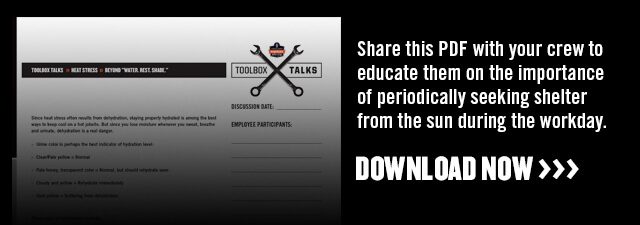Why Shaded Areas are Important For Breaks at Work - Toolbox Talks
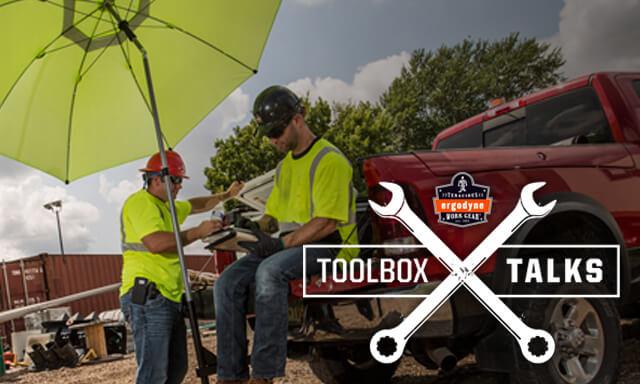
In 2014, OSHA kicked off an annual campaign to train and educate workers about heat stress management called Water. Rest. Shade. The following post will focus on shade.
Share this Toolbox Talk PDF (Topic: Shade) with your crew to educate them on the importance of periodically seeking shelter from the sun during the workday.
Go ahead, throw some shade. With summertime temps getting more and more extreme, you need to be prepared to handle any heatwave and keep your workers safe. Giving your workers access to outdoor sun protection is critical in keeping them healthy and productive, come hell or high temperatures.
Heat stress and heat-related illnesses are serious business. A heat-stressed body is less productive, fine motor skills are impaired, and if allowed to get too hot without adequate rest and water, heat stress can lead to heat stroke which can be deadly. Heat can be blamed for an average of 650 deaths in the U.S. each year, according to the Centers for Disease Control and Prevention.
THE IMPORTANCE OF SHADE
It may feel counterintuitive that offering more breaks can get more work accomplished, but when it comes to the summer heat and blazing sun, it’s true. Workers that have a chance to periodically rest in the shade for at least a duration of 5 minutes are more productive than those that don’t have a chance to rest. According to a USA Today report, 65% of workers either don’t want to work, or work at a much slower pace in the heat and humidity. And those suffering from heat stress can experience confusion and impacted fine motor skills, which can be dangerous on a jobsite.
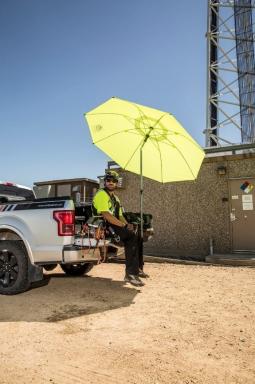
Providing access to shade on the jobsite is so important that some states, like California and Washington have regulations that require it. The California regulation states that when the outdoor temperature in the work area exceeds 80° F, an employer must offer at least one area with shade that is either open to the air or provided with ventilation or cooling. And for temps under 80° F in the work site, an employer must still offer a shade option or access to shade on demand. At 95° F and up, the employer must ensure each worker takes a minimum 10-minute cool down in the shade every two hours.
WHAT IS SHADE?
“Shade” is defined as the blockage of direct sunlight, and the blockage is considered sufficient when objects do not cast a shadow in the shaded area. Shade is not considered adequate when the level of heat in the shaded area doesn’t allow the worker to cool down. An example of this would be having a worker take a cool-down break in a car that’s sitting in the sun, without the air conditioning running. The interior of a vehicle can be used as shade as long as the vehicle is running constantly for the entire workday with the air conditioning on.
Sunshade may be provided by any natural or artificial means. Buildings, canopies, lean-tos and other temporary structures can serve as shade as long as they’re ventilated or open to air movement while blocking the sun. Trees can provide shade as long as the canopy of the trees is sufficiently dense to provide complete blockage of the sun, and the branches are high enough that workers don’t have to crouch or bend to avoid the branches.
The amount of shade must accommodate the number of employees on recovery or rest periods, with enough space that they are able to sit in a normal posture without being in physical contact with other workers. And shade must be as close as practical to where employees are working, and should not be challenging or dangerous to get to, or difficult enough to get to that it deters workers from taking advantage of it. Water should be available for workers and encouraged during rest breaks.
Workers should always be allowed and encouraged to take a cool-down break in the shade when they need one in order to protect themselves from a heat-related illness. Workers that take a preventative cool-down rest should rest for no less than five minutes, and be monitored and asked if they are experiencing symptoms of heat stress. They should also be allowed to stay in the shade until they’re feeling well enough to return to work, and should not be ordered to return to work until any symptoms of heat illness (heavy sweating, headache, muscle cramps, pale skin, and fatigue are common early signs) have abated.
Employing a “buddy system” can help workers look after one another and watch for signs of heat stress. Buddies can help look out for hazardous conditions, including how their buddy is handling the heat. According to the CDC, workplace buddies should be able to identify their partner’s strengths and weaknesses, monitor their buddy for stress (including environmental stress), check on workload and encourage breaks when needed. Workers may not realize they’re being affected by the heat until it’s too late, but having a buddy check in on them may help encourage cool-down breaks in the shade.
TYPES OF PORTABLE SHADE
Get shady. There are a number of shade solutions that are all quick and easy to deploy at your jobsite. From large pop-up shelters to light-blocking umbrellas, you’ve got options when it comes to providing your workers with the shade they need to keep going.
Pop-Up
Pop-Up tents and shelters are a simple way to provide outdoor shelter with a larger area of shade for your workers. The UV coatings block the sun’s rays and the PU coating repels water to keep your crew dry in the rain. These shelters pack in their own bags and can easily be put up or taken down to move from jobsite to jobsite. The tent kits include side walls for extra element-blocking power. From a 10x10’ up to a 10x20’ footprint, you’ll have more than enough room to keep your crew comfortable.
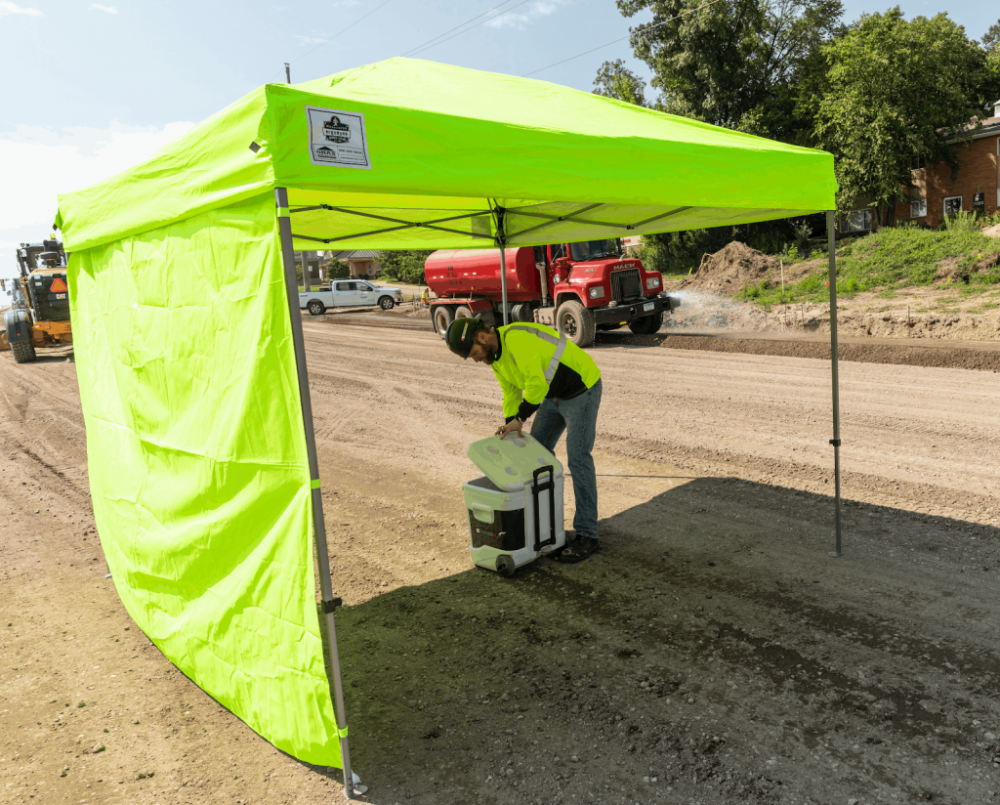
Umbrella
An umbrella shelter provides protection against the elements for a single person. Umbrella shades travel easily and can go where other bulky tents or shelters can’t. UV blocking and PU-coated to fend off both sun and rain. A durable stand makes this one easy to pop up on any jobsite. An optional hitch mount lets you mount the umbrella to your truck, for a shady break on the tailgate.
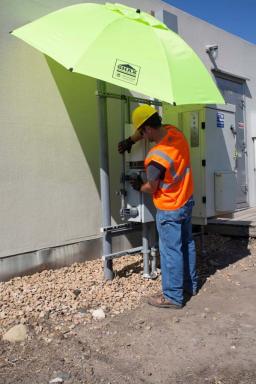
Accessories
Tent and umbrella accessories make your shady spot that much cooler. A misting system can cool the ambient air by 30 degrees F and requires no running water, just pump to get 20 minutes of cooling. Adding tent sidewalls to any pop-up tent keeps the sun from sneaking in on the sides, and can help block the wind and rain on those days where the rain seems to be coming in sideways.
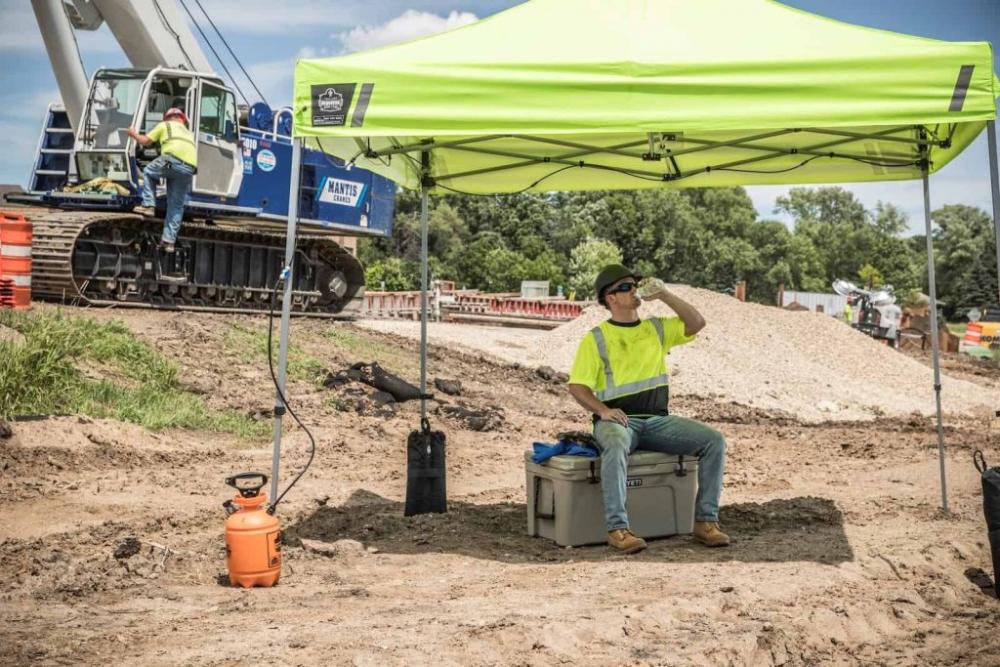
SMART WORK SCHEDULING
If possible, avoid scheduling strenuous manual labor for your workers in the middle of the day. Work should be shifted when possible to either before or after the hours of 10 am – 2 pm. If it’s not feasible to avoid those hours completely, smart scheduling techniques can help with moving the most intense labor to cooler parts of the day.
The heat index is a measure indicating the level of discomfort the average person feels in the shade due to the heat and humidity in the air. The chart from NOAA shows the “feels like” temperature based on the air temperature and relative humidity, along with color-coded likelihood of heat-related illnesses as the temps and humidity climb.

For a more accurate measure of just how hot it will be at your site, use the Wet Bulb Globe Temperature (WGBT) that comes from a specialized device which measures heat stress in direct sunlight and takes into account temperature, humidity, wind speed, sun angle and cloud cover. This chart offers a suggested schedule for work, rest and water intake based on the WBGT reading.
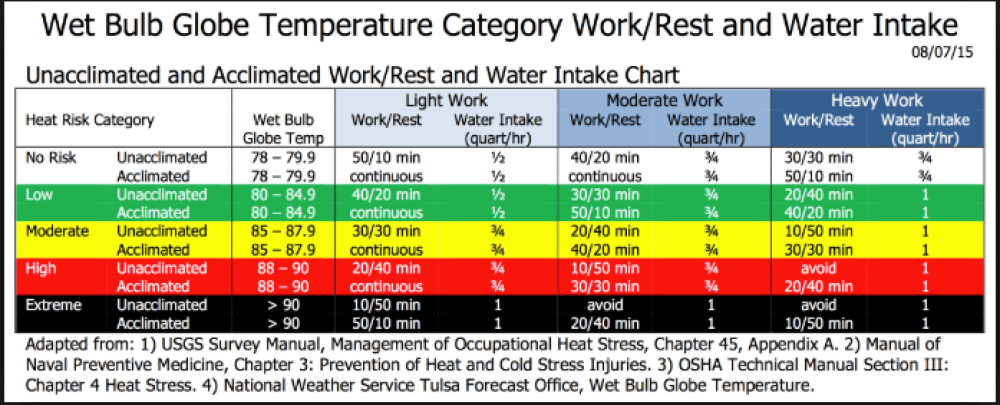
DRESS FOR THE HEAT
The reality is, shade is important, but mitigating the sun when workers can’t be in the shade is even more important for workplace safety. There a lot of solutions for keeping your workers cool when they’re out in the sun, from shades to cooling towels and vests that use the power of evaporation to keep your crew cool.
Adding a hard hat brim shade or neck shade keeps the sun off their neck, reducing the risk of sunburn which quickly saps workers of energy. Look for neck shades that use evaporative cooling technology for another layer of cooling power while keeping the sun’s rays at bay.

Like hard hat brims, wide-brimmed hats are great for keeping the sun off their face and neck. Evaporative cooling hard hat pads, liners or bandanas add hours of cooling with just a little water. Cooling towels around the neck (or any pulse point like wrists, behind knees, inside the bend of the elbows) can keep the pulse points in the neck cool, which delivers cooler blood to the rest of the body. These evaporative cooling pieces soak up the water then let it evaporate over time, cooling down the body much like how the body naturally cools itself by sweating.
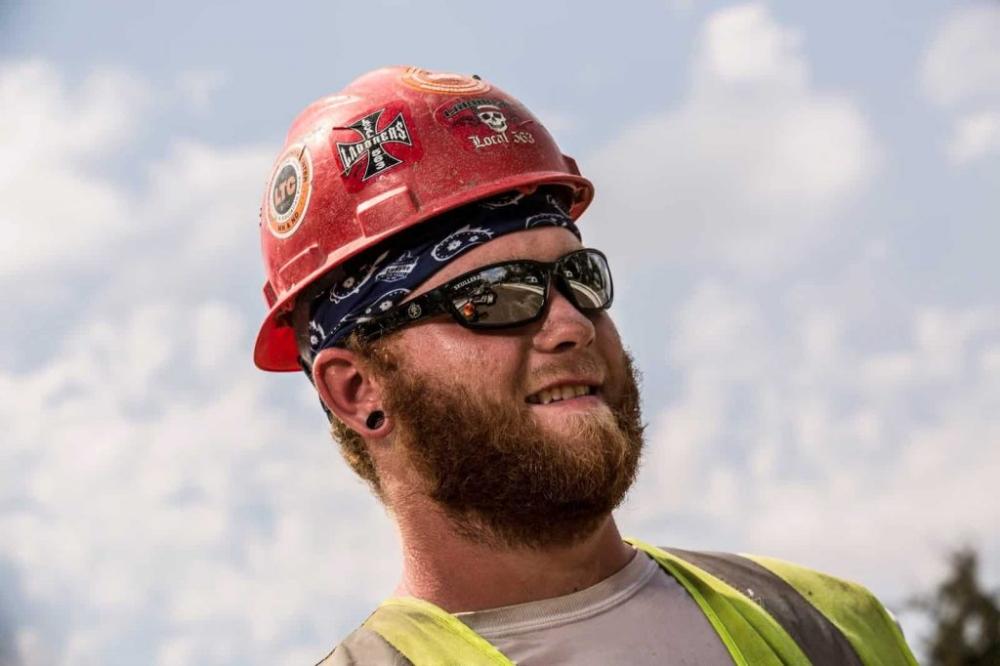
When it’s really hot, evaporative cooling vests can keep the worker’s core cooler by adding water and letting evaporation do its thing. By keeping the core cool, the rest of the body stays feeling much cooler. Heat stress happens when core temperature rises. By keeping the core temperature cooler with a vest, the body will be cooler and less susceptible to heat stress. Evaporative vests require water and airflow and are best used in outdoor environments with low humidity. These options are great for construction, landscaping, maintenance and more.
A phase-change cooling vest maintains a cool temp of 64 degrees for up to two hours after activation and is lightweight yet effective. These types of vests cool the body similarly to an evaporative cooling vest, but they don’t require airflow to work, so they can be worn under PPE like coveralls or hazmat suits. These type of vests are best for hot indoor environments like pulp/paper, iron/steel fabrication, refineries, and foundries. For a closer look at the different cooling vest options, check out our quick visual guide to cooling vests.
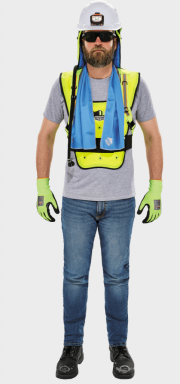
Another key to keeping cool is wearing lightweight, breathable clothing, and applying sunscreen frequently to block harmful UV rays and help avoid heat stress and overexertion in the sun. Sunburn decreases the body’s ability to vent heat and cool itself, and sunburned bodies are more susceptible to overheating.
TALK TO YOUR CREW
Because the job has to get done, no matter what the weather is doing, it’s important to take a few minutes to talk to your crew about the importance of taking the time to rest in the shade. Adding a shelter or canopy to your worksite can increase productivity in the hot summer months, while reducing the likeliness of your crew suffering from heat stress.


